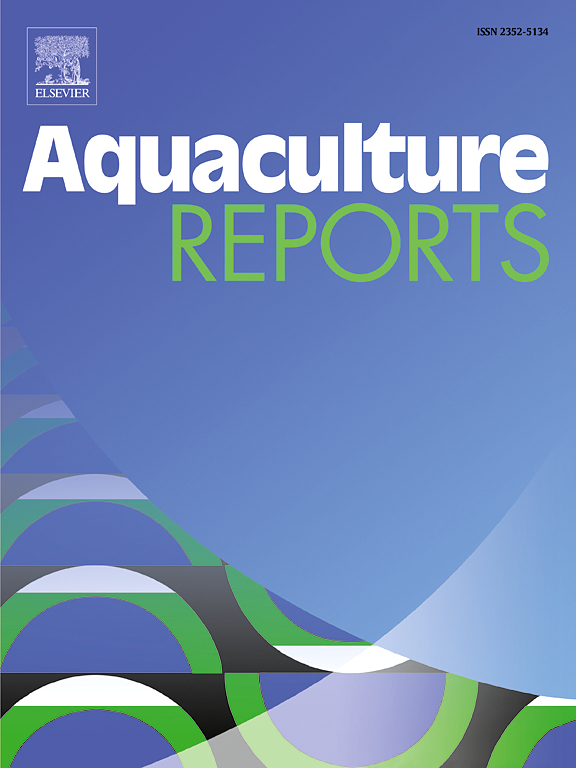Mesquite seed flour as a nutrient-rich alternative to fishmeal for common carp fingerlings (Cyprinus carpio): Environmental, growth performance, transcriptomic and intestinal microbiota responses
IF 3.2
2区 农林科学
Q1 FISHERIES
引用次数: 0
Abstract
This study evaluated the potential of mesquite seed flour (Prosopis laevigata) as an alternative to fishmeal (FM) in the diets of common carp fingerlings (Cyprinus carpio). A mesquite diet (MD) was formulated containing 48.8 % mesquite flour, 24.4 % fishmeal and 20.7 % corn flour. Over a 45-day trial, 1000 fingerlings were distributed across four tanks (two tank replicates per diet). The carried-out methodology included growth parameters and water quality evaluation, RNA sequencing from liver tissue, and 16S sequencing of intestinal microbiota composition. Both MD and FM diets provided optimal water quality conditions for the growth and well-being of fish during the experiment. Growth performance resulted similarly between MD and FM, with no significant differences in weight gain (379.40 ± 232.55 % for FM and 335.08 ± 219.69 % for MD). Transcriptomic analysis revealed differentially expressed genes involved in lipid metabolism, particularly fatty acid degradation and PPAR signaling pathways. Intestinal microbiota evaluation indicated diet-specific modulation in microbial composition since differences in the relative abundance of shared species between diets was identified. Additionally, MD-fed carp showed unique bacterial species, such as Shewanella putrefaciens and Myxococcus xanthus, while FM-fed fish showed Shewanella hanedai and Archangium disciforme. This study represents the first multi-omics approach, incorporating transcriptomics and metagenomics, to evaluate the effects of mesquite meal supplementation in an aquaculture species as an alternative to fishmeal for enhancing aquafeed sustainability.
豆科植物种子粉作为鱼粉营养丰富的替代品用于普通鲤鱼鱼种:环境、生长性能、转录组学和肠道微生物群反应
本研究评价了豆科植物种子粉(Prosopis laevigata)作为普通鲤鱼鱼粉(Cyprinus carpio)饲料替代品的潜力。配制了豆科植物饲粮(MD),其中豆科植物粉含量为48.8 %,鱼粉含量为24.4 %,玉米粉含量为20.7 %。在45 d的试验中,1000尾鱼种分布在4个槽中(每个饲粮重复2个槽)。研究方法包括生长参数和水质评价、肝组织RNA测序和肠道菌群组成16S测序。在试验期间,MD和FM均为鱼类的生长和健康提供了最佳的水质条件。MD和FM的生长性能相似,增重无显著差异(FM为379.40 ± 232.55 %,MD为335.08 ± 219.69 %)。转录组学分析揭示了参与脂质代谢,特别是脂肪酸降解和PPAR信号通路的差异表达基因。肠道微生物群评估表明,由于确定了不同饮食之间共享物种的相对丰度差异,因此饮食特异性调节了微生物组成。此外,在饲料中发现了腐坏谢瓦氏菌和黄粘球菌等独特的细菌种类,而饲料中发现了汉代谢瓦氏菌和变形大弧菌。本研究首次采用多组学方法,结合转录组学和宏基因组学,来评估在水产养殖物种中添加豆科植物粉作为鱼粉替代品对提高水产饲料可持续性的影响。
本文章由计算机程序翻译,如有差异,请以英文原文为准。
求助全文
约1分钟内获得全文
求助全文
来源期刊

Aquaculture Reports
Agricultural and Biological Sciences-Animal Science and Zoology
CiteScore
5.90
自引率
8.10%
发文量
469
审稿时长
77 days
期刊介绍:
Aquaculture Reports will publish original research papers and reviews documenting outstanding science with a regional context and focus, answering the need for high quality information on novel species, systems and regions in emerging areas of aquaculture research and development, such as integrated multi-trophic aquaculture, urban aquaculture, ornamental, unfed aquaculture, offshore aquaculture and others. Papers having industry research as priority and encompassing product development research or current industry practice are encouraged.
 求助内容:
求助内容: 应助结果提醒方式:
应助结果提醒方式:


